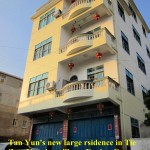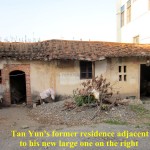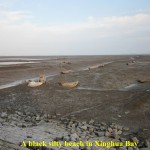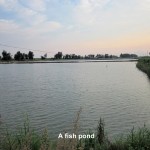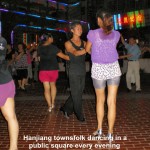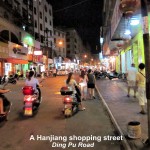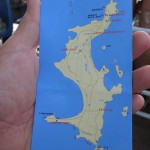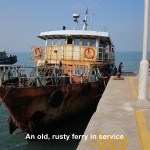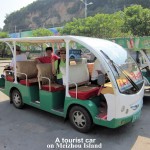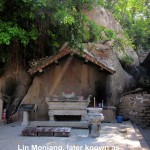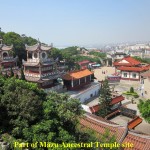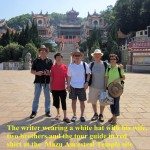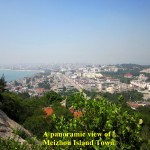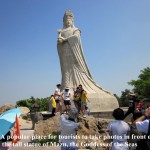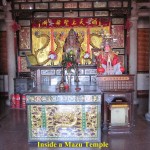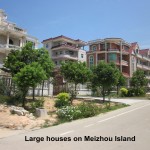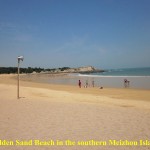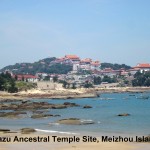China Relatives and Ancestral Places II (Fujian Province, Meizhou Island)
Filed under: China Relatives and Ancestral Places II (Fujian Province and Meizhou Island), China(Relatives)
(Continued from China Relatives and Ancestral Places I)
Chinese Relatives and Ancestral Places II
(Fujian Province, Meizhou Island)
(Day 3 Sunday 5 September 2010
After visiting all my relatives for the past two days, we decided to do some shopping and visit some
places of interest for the rest of our vacation.
In the morning we checked out of the hotel because Brother Tan Yun, our guide, invited us to put up at his house. It was in Tie Zao Village in Nanxing near Hanjiang Town. His hospitable mother and wife welcomed us, and took care of our meals and laundry. Brother Tan Yun’s newly built large house of three storeys next to his old one surprised us. When we asked him about it he told us that he had made a small fortune overseas and built it. He built it large to “show off’ to his villagers. That was another case of a large house built by a successful son who had earned lots of money overseas to build a large modern house to “show off”.
In the evening, one of my brothers, Cho Tat, and I decided to take a walk from the house to the Xinghua Bay. We needed that walk to burn off some of our fat as we had been eating too much delicious food, lately. At first, we thought it was a short distance to the beach. Later, we realised that it was quite a long one taking us about 40 minutes.
When we reached the beach we were surprised to see it covered with black silt, instead of white or golden sand. As the tide was low the exposed beach stretched for about 1 kilometre from the sea-wall of stones to the water. That place was flourished with crabs, clams and prawns when it was high tide. These sea animals were the source of income for many villagers there. Besides, they reared fish, prawns and crabs in ponds they made near their houses for extra incomes.
In the evening, Brother Tan Yun drove all of us to Hanjiang Town to have a simple local meal. Then he
brought us to a public square to watch some townfolks dancing. It was interesting to watch them dancing to the loud Chinese and Western musics. This is a common pastime in most of the places in China.
Then we left the place for a well-known Hanjiang shopping street, Ding Pu Street. The shops along that street were selling goods ranging from clothes to electrical and electronic goods. A brother of mine bought a pair of sports shoes in one of them and was given a free pair.
Day 4 Monday 6 September 2010
Meizhou Island
After breakfast, we travelled to Wenjia Town, a coastal town, which is 42 km south-east of Putian City. On arrival, we took an old rusty ferry-boat to a famous small island, Meizhou Island, which is about 2 nautical mile from the mainland. As we were crossing the channel, we sighted a statue of the Goddess of the Sea on a hill on the island. The name of the world famous goddess is Mazu.
Mazu, the Goddess of the Seas
According to the local legend, a girl, Lin Moniang, was born to a fisherman in A.D. 960 on the island. One night, Moniang dreamt that his father and brothers were in danger when their boat capsized at the rough sea. She quickly woke up, rushed to the beach and rowed a boat out to the sea searching for them, frantically. But, unfortunately, she managed to rescue her father only. The following day, news spread like wild fire in her village that she had done a courageous deed.
When she was 27 years old and in the 99th. Festival in A.D. 987, she went to the highest hill, Meifeng Hill, ascended to the heaven and disappeared. Since then the villagers considered her the Goddess of the Sea and called her Mazu. They worshipped her and asked for her kind blessings at a temple they built at the place where she went to heaven. Later, more Mazu temples were built around it for both local and foreign worshippers. This temple site is now known as the Mazu Ancestral Temple covering a large area of over 33,000 sq. metres. It has become a famous tourist attraction worldwide.
Mazu Ancestral Temple Site
After half an hour of the slow but enjoyable boat ride to Meizhou Island, we arrived at the island, finally. We booked a tourist car to tour the whole island. The first place we visited was the Mazu Ancestral Temple Site. Arriving at the foot of Meifeng Hill, we got down the car and walked up a few hundred steps to the top. While walking up the hill we stopped at a few spots to see Mazu temples. On higher ground, we saw awesome sights of the Mazu Ancestral Temple site, Meizhou Town and the blue sea that surrounded the island.
Statue of Mazu
On top of the hill, we saw a large, tall, grey statue of the Goddess of the Sea, Mazu. It is 14.35 metres high and made of 365 pieces of stone with the belief that Mazu will bless her worshippers all year round(365 days). This place is the most popular place for tourists to take photos with the towering statue. We spent a few minutes there taking some photos, watching tourists and enjoying the stunning scenes of the temple site, landscapes and seascapes. Then we followed a winding path down the hill looking at several spots where life-sized figures stood depicting the life history of Mazu.
Walking down the hill further, we came across more temples, such as Lingei Temple, Shunji Temple of Blessing, Temple of Heavenly Queen, etc.
Finally, we had lunch at a restaurant, Yiseyuan Restaurant, in the Drum Tower at the Mazu Ancestral Temple site . After that satisfactory meal, we left the place and continued our tour of Meishou Island.
Golden Sand Beach
As we were heading for the Golden Sand Beach, we saw many beautiful western-styled houses of three or four storeys. According to our Meizhou Island tour guide, they were built by rich China Mainland businessmen. They built them hoping to sell them to wealthy overseas Chinese who intended to retire there. But, many of them were unsold then, as rich overseas Chinese feared armed robberies might happen on the quiet island.
Soon, we reached the Golden Sand Beach. Standing on the beach, I could see the fine sand in golden colour and some people enjoying swimming in the hot sun. As it was too hot at the beach we left and travelled along the coastal road enjoying the beautiful sights of the sea and the landscapes.

